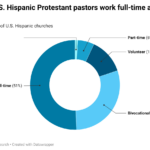
Christians should grow in these attributes. Conversely, if you’re not seeing growth in these areas, discipleship may have stalled out.
By Michael Kelley
Imagine yourself on a trail deep in the woods. You’ve been walking for a long time, and though you set out on a clearly marked trail, it’s been quite some time since you’ve seen any markers. The undergrowth has become thick; there are few signs that people have regularly walked this way before.
It’s at that moment that you would hope to encounter some kind of signpost—a marker placed along the path to help you know for certain that you’re still going the right way, how far you’ve come, and even how far you have to go.
This is what signposts do on a path—they convey information about the progress you’re making.
As a church leader, perhaps you know that feeling of being deep in the woods. You intend to guide your congregation on the pathway of discipleship and spiritual development, but sometimes it’s hard to know if people are truly making progress.
Like the person deep in the woods, you long for some kind of signpost that indicates you’re still on the right track.
Throughout the last decade, Lifeway Research has engaged in the largest research study of its kind around the subject of discipleship. This included a qualitative survey of experts in the field of discipleship including pastors, professors, and church leaders from a variety of backgrounds to the major areas of life where spiritual maturity takes place.
The study included two surveys of 1,000 Protestant pastors in the United States to discover the type of discipleship ministries being used in churches and the satisfaction level that they have with them, and two additional surveys of 4,000 and 2,500 Protestant churchgoers regarding their personal practice of discipleship.
All this research identified eight domains of the Christian life that lead to spiritual health in a believer. These attributes of discipleship serve as signposts on the pathway of discipleship. In other words, these are the characteristics that ought to be present, in increasing measure, in the life of someone who is growing toward Christlikeness.
1. Bible engagement: Transformation can be recognized when our mind is sharpened by the Bible, our perspective is shaped by the Bible, and our actions are directed by the Bible.
2. Obeying God and denying self: Discipleship is the process of obedience to one who is in authority over you. Transformation can be seen when we progressively set aside earthly delights for kingdom priorities.
3. Serving God and others: Transformation is evident when personal needs and even dreams are set aside for the needs we see in others.
4. Sharing Christ: Even with the need to live out the effects of the gospel, maturing believers know speaking about the message is a necessity. Transformation is evident when we talk about the source of it.
5. Exercising faith: Transformation is seen in believers when risk aversion is set aside and our lives are characterized by faithful obedience to God’s will.
6. Seeking God: Transformation is seen when our desire is to know God more deeply and experience His work more fully.
7. Building relationships: Our faith is personal but it is not intended to be private. Our horizontal relationships should develop just as our vertical relationship with God does. Transformation occurs when relational maturity is evident in our lives.
8. Unashamed: Transformation is evident when a believer is unashamed to present their own life as being aligned with Christ.
As the signposts of the discipleship pathway, these are the statistically validated marks of transformation that show people are on the right track. They are growing disciples of Jesus, and that growth is displayed through attributes like these.
When we turn to Scripture, we find the Bible describing these signposts using the word “fruit.” In this agricultural metaphor that is often employed by biblical authors, we see clearly how transformation leads to visible acts of obedience.
For just as a tree produces fruit according to its kind, so also will someone who is genuinely a Christian have visible marks of their transformation apparent in their lifestyle.
Are these the only signposts for the Christian? They aren’t. Paul described other types of fruit in Galatians 5:
“But the fruit of the Spirit is love, joy, peace, patience, kindness, goodness, faithfulness, gentleness, and self-control” (Gal. 5:22-23).
Christians should grow in these attributes as time goes by. Conversely, if you’re not seeing growth in these areas, discipleship may have stalled out in the congregation.
So what do you do if that’s the case? How can you help people get back on the right track?
The first step is to make sure people understand the pathway they’re on. No matter how hard we try, there are still many in our congregations who do not understand that the moment of salvation is not the end for them; it’s only the beginning of a life long pursuit of Christlikeness.
This pursuit takes intentionality on their part; they must give themselves in surrender to the work of the Holy Spirit in their lives.
One way to remind people of this fact is to present a clearly articulated pathway of discipleship. There are many ways churches have done this in the past; at Lifeway, we recommend a pathway that incorporates these eight signposts of spiritual growth and development.
More and more, church leaders are delegating the responsibility of choosing Bible study resources to individual group leaders. That’s a fine practice as long as those group leaders know, understand, and are committed to the overall pathway of discipleship for the ministry.
Whether you, as a church leader, dictate the resources for the ministry or you allow a degree of freedom to the group leaders, each must be done with care to make sure those resources are centered on the gospel and help people move forward in key areas of spiritual growth and development.
Having adopted and articulated a pathway of discipleship, you can begin to resource your congregation accordingly. There are two easy ways to do this if you’d like to incorporate these eight signposts into your pathway.
Lifeway has developed resources that align directly with this discipleship pathway, including Bible Studies for Life curriculum. This line of Bible studies is designed according to this pathway, and each year of Bible Studies for Life will systematically emphasize each of the eight signposts.
Every one of us in Christ is on a pathway. Let’s do all we can to make sure our people are clear about the one they need to be walking on.

Michael Kelley
Michael is the Executive Director of the Rooted Network. He is the author of several books, including Creating a Discipleship Pathway.












